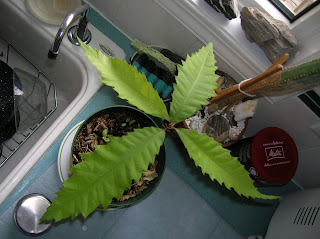While waiting for the grain off hide in the tea bucket to take up the nice brown colour, I decided to make something else from the sample piece of tea tanned leather ....
First, grab yourself a deer neck skin; if it's rawhided, rehydrate it. If it's frozen, thaw it out. If it's still on a live deer "ketch da deer, killit an skinit". In my case it was frozen with the hair still on, so into a bucket of soapy room temperature water it goes!
After you wash out the blood, goo, rutty smell, dirt, etc ... dry off the hair side (hair dryer, roll up in a towel, whatever works for you) and tack it on a flat board to dry out the flesh side.
Once dry, scrape off membrane, dried "hide snot", and other superfluous tissues.
While waiting for the piece to dry out, take all the used tea leaves (teabags, too!) and boil yourself a nice tub of tea liquor. Doesn't have to be extra strong for the first soak, just strong enough to discourage rot.
In about a week, the hair will start to slip - if you have the solution too strong, it'll take longer or won't slip at all. Rub your fingers to remove the hair and epidermis but leave the grain intact. If you're using really acidic tannin source (like spruce bark, say) soak it in plain water for 3-4 days to slip the hair first before you tea it.
3 days later. Nice golden colour to the leather's grain side
After a month, the leather has struck through - not "full" of tannin, but the centre of the skin is golden-orangey hued instead of bluish white of untanned leather. Take the piece out of the bath, and give it a good rinse with plain water to wash out unfixed tea tannins.
 |
| Grain side - golden brown! |
 |
| Flesh side - deep cocoa! |
Roll the piece up in a small towel to drain off excess moisture, then rub in the leather mayo (1/3 soap + 2/3 oils) into the flesh side. Work it in well until it's slightly oily (the fibres will absorb the oils as it dries). The flesh side will darken into a nice mahogany colour.
Here's where I did something really stupid - DON'T LET WET TANNIN LEATHER COME INTO CONTACT WITH METAL! IT WILL STAIN!!!
Well, good thing stains does not affect the function. Now I tacked the piece flat on the boar, grain side out, and rolled a smooth rounded glass object (marble, jam jar, crystal ball, etc) on the grain, pressing down, so it'll dry flat and have a tighter look. Then, to increase waterproofing, rub in a good dollop of dubbin.
Look at how the grain compares to an "unrolled grain" leather. It's from the same piece of neck skin, treated using the same tea bath, but was let dry un-tacked and un-rolled.
here comes the phone holster makin' bit. Cut out a paper pattern of your phone holster and place it on the leather bit. This is to maximise leather use and reduce wastage - plus it'll let you figure out how to cut the leather.
Obviously, make sure the paper pattern does form a holster shape and fit your phone.
Make a "body double" of your phone using thick hard cardboard - make sure the dimensions match, as we will use it in the final form fitting stage! Draw funny pictures on it to amuse yourself, if you're easily bored like me.
Now cut the paper pattern open, lie it flat on the leather and use binder clips to secure it in place while you cut out the leather bits.
Taa daaa! Front panel, back panel and belt loop.
Sew on the belt loop first, before you stitch the sides. Tea tanned grain on leather is really hard, so poke holes with an awl, or any sharp pointy things you have so you don't break your needle. Also help if you soak the leather in water for 30 mins or so, to soften it a bit.
I actually used real deer sinew that I harvested from the deer's main quadriceps muscle. Pound the dried sinew to separate the fibres, then pop it in your mouth (yes, I did! Taste like deer jerky) and chew it to moisten and soften it. The sinew is very strong stuff, and has natural glues that will keep the stitches tight and waterproof as it dries.
All the sewing done!
Now here is where you need the cardboard phone. When the leather holster is still moist, soft and pliable, stuff the phone's body double into it and let it dry overnight. The leather will shrink and harden, and conform to the shape of the cardboard phone, ensuring a perfect fit to your real phone!
Will continue when I figure out the clasp! So there you go - 2 hours of leather cutting and sinew sewing, and you have yourself a primitive lookin' phone holster, made from genuine deer leather!



















































